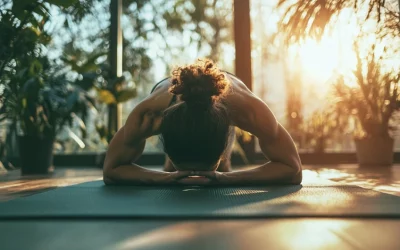Do your arms feel like you’re dragging a pair of anchors with you? If that’s the case, stretching can make a big difference. Regular arm stretches not only help increase flexibility but can also improve your overall range of motion. Whether you’re recovering from tightness or just looking to improve mobility, simple stretches can be effective and time-efficient.
This article provides a list of easy arm stretches you can start doing today to improve flexibility. Pay close attention and you will be able to shake off those anchors that are weighing you down, lickety-split!
The Importance of Arm Stretches
Arm stretches are essential for improving arm flexibility and maintaining joint health. With regular stretching, you allow the arm muscles to become more pliable, which helps them extend further over time. This increase in flexibility enables you to move your arms more freely, making daily activities like reaching, lifting, or even typing more comfortable.
In addition to flexibility, arm stretches also improve your range of motion, which refers to how far you can move your joints in different directions. With a better range of motion, tasks like grabbing something off a high shelf or throwing a ball become smoother and less strenuous. This can make a noticeable difference in how easily you move through everyday tasks.
Moreover, arm stretches play an important role in injury prevention. By loosening tight muscles and improving joint mobility, you reduce the risk of muscle strain or joint stress. This is particularly important for those who engage in repetitive arm movements, such as athletes or people with desk jobs. When your muscles are more relaxed and your joints move freely, you’re less likely to experience stiffness or discomfort after prolonged use.
 Effective Arm Stretches to Improve Flexibility
Effective Arm Stretches to Improve Flexibility
1. Overhead Triceps Stretch
The Overhead Triceps Stretch is a simple yet effective way to improve flexibility in the upper arms and shoulders. It’s a great stretch for anyone looking to enhance their range of motion, especially if you spend a lot of time sitting or working at a desk.
To perform the stretch:
-
Stand tall with your feet shoulder-width apart.
-
Raise one arm overhead, bending the elbow so that your hand reaches down toward the middle of your back.
-
Use your opposite hand to gently press down on your bent elbow.
-
Keep your back straight and engage your core to maintain proper posture.
-
Hold the stretch for up to 30 seconds, then switch arms.
This stretch mainly targets the triceps and shoulders, helping to release tension and improve flexibility in these key areas. Over time, it can contribute to better posture and reduce upper body stiffness.
If you’re new to stretching or have limited mobility, you can modify the stretch by not pulling the elbow down as far or by sitting in a chair for added support. These adjustments make the stretch accessible to all fitness levels while still providing the benefits.
2. Cross-Body Shoulder Stretch
The Cross-Body Shoulder Stretch is an effective and straightforward method to increase shoulder flexibility and boost mobility. This stretch targets the deltoids and upper back, helping to loosen tight muscles and increase your range of motion.
To perform the stretch, follow these steps:
-
Start by standing or sitting with your feet shoulder-width apart.
-
Extend one arm straight across your chest.
-
Use your opposite hand to gently pull the extended arm closer to your body.
-
Keep your shoulders relaxed and avoid twisting your torso during the stretch.
-
Hold this position for up to 30 seconds, then switch arms.
This stretch is valuable for improving shoulder mobility, particularly in the deltoids and upper back, where tension often builds up. By incorporating it into your routine, you can reduce stiffness and improve your ability to perform overhead and rotational movements.
However, to get the most benefit, be mindful of common mistakes. Avoid pulling your arm too forcefully, as this can lead to strain. Also, make sure not to hunch your shoulders—keeping them relaxed is important for a safe and effective stretch.
3. Wrist Flexor Stretch
The Wrist Flexor Stretch is important for improving wrist flexibility and reducing tension, especially if you frequently use your hands for typing, writing, or other repetitive tasks. To perform this stretch correctly, follow these steps:
-
Start by extending one arm straight in front of you, with your palm facing up.
-
Use your other hand to gently pull back on your fingers, making sure that your wrist remains aligned with your arm. Avoid bending your wrist too far down or twisting it.
-
Hold this position for up to 30 seconds, feeling a mild stretch along the underside of your forearm and wrist.
-
Switch arms and repeat the stretch on the other side.
This stretch can alleviate wrist pain and tension, which is common for people who spend long periods in front of a computer or working with their hands. When done regularly, it helps prevent tightness and can improve your overall wrist flexibility.
4. Wrist Extensor Stretch
The Wrist Extensor Stretch is an essential exercise to counteract tension in the wrist and forearm. By regularly practicing this stretch, you can improve flexibility and reduce the risk of stiffness in the forearms.
To perform the stretch:
-
Extend one arm straight out in front of you with your palm facing downward.
-
Use your other hand to gently pull the fingers of the extended hand back toward your body.
-
Keep your arm straight and apply light pressure until you feel a stretch along the top of the forearm and wrist.
-
Hold the position for up to 30 seconds, then repeat on the opposite arm.
This stretch is particularly beneficial for relieving wrist tension that builds up from repetitive activities like typing. Maintaining a straight arm and applying only gentle pressure is key to avoiding strain while still gaining the stretch’s flexibility benefits.
5. Side Stretch
The Side Stretch is an easy but effective exercise that focuses on both your arms and torso, enhancing flexibility and expanding the range of motion in these regions. To perform the stretch, follow these basic steps:
-
Stand upright with your feet shoulder-width apart.
-
Raise your right arm overhead, keeping it straight.
-
Slowly lean your torso to the left while reaching your right arm over your head.
-
Hold the position for up to 30 seconds, then switch sides.
Make sure to engage your core muscles throughout the stretch. This helps stabilize your body, preventing any strain on your lower back and allowing you to deepen the stretch safely. Engaging your core also supports better alignment, which is important for getting the most out of the stretch.
The Side Stretch not only improves flexibility in your arms but also enhances mobility in your torso. By loosening up the muscles along your sides, including the obliques, you’ll benefit from better overall movement and posture.
 Useful Tips for Effective Stretching
Useful Tips for Effective Stretching
Proper Warm-Up
Warming up before you stretch is important to prevent injury and improve flexibility. By increasing blood flow to your muscles and gradually raising your heart rate, a proper warm-up helps prepare your body for the demands of stretching. This reduces the risk of strains and ensures that your muscles are more responsive, making your stretches more effective.
A short, dynamic warm-up works best. Instead of holding static positions, focus on movements that engage your arms and shoulders. Some simple exercises to try include:
-
Arm circles: Extend your arms out to the sides and rotate them in small and large circles, both forward and backward.
-
Light cardio: Spend a few minutes brisk walking, jogging in place, or doing jumping jacks to get your blood flowing.
-
Shoulder rolls: Gently roll your shoulders forward and backward to loosen up the joints and muscles.
These dynamic movements will help activate your muscles and improve your range of motion, setting you up for a better and safer stretching session.
Deep Breathing
Breathing deeply while stretching is key to improving both your physical and mental experience. By syncing your breath with each movement, you can enhance your focus and relaxation, making your stretches more effective. This simple practice helps you stay present, allowing your mind to concentrate on the stretch instead of distractions.
Deep breathing also plays an important role in boosting oxygen flow to your muscles. When you take long, controlled breaths, your body delivers more oxygen to the areas being stretched. This increased oxygen helps muscles relax, reduces tension, and improves the effectiveness of the stretch.
I’ve noticed that deep breathing isn’t just good for my body; it really helps calm my mind, too. When I pay more attention to my breath while stretching, it turns the routine into something more mindful. Not only does it help me become more flexible, but it also brings a sense of relaxation and clears my head.
Avoid Pain
To stretch safely and effectively, it’s important to avoid pain and overstretching. This means you need to listen to your body throughout each stretch. Stretching should lead to a sensation of gentle tension, which indicates that your muscles are being engaged. However, if you feel sharp or intense pain, this is a signal that something is wrong.
The key difference between tension and pain is that gentle tension feels like a mild, controlled stretch that can be held comfortably, while pain is more intense and can feel sudden or sharp. If you experience pain, stop the stretch immediately. Ignoring pain could lead to injury or indicate improper technique.
Consistency
Maintaining consistency in your stretching routine is important if you want to see long-term flexibility improvements. Without regular practice, your progress can easily stall, or worse, reverse. To build and maintain flexibility over time, it’s essential to stick to a schedule that works for you. Whether it’s stretching daily or several times a week, committing to a routine will help you achieve lasting gains.
Creating a regular stretching schedule will help keep you on track. You don’t need to dedicate a lot of time each day; even 5-10 minutes of focused stretching can make a difference over time. The key is to keep at it:
-
Set aside specific times of day, such as mornings or after workouts.
-
Incorporate stretching into your existing routine, like after a shower or before bed.
-
Use reminders or apps like WeStretch to help you stay consistent. WeStretch‘s dashboard and leaderboard functionality allow each user to easily track their progress and maintain a consistent routine.
By maintaining consistency, you not only prevent setbacks in your flexibility but also ensure steady progress. The more consistently you stretch, the more your muscles adapt and become flexible. This commitment ultimately leads to a better range of motion and a reduced risk of injury in the long run.
Exercise Smarter with WeStretch: Your All-in-One Stretching Assistant
A consistent full-body stretching routine is essential for improving flexibility, supporting injury prevention, and enhancing overall well-being. Carefully following simple yet effective stretches targeting the hamstrings, hip flexors, back, quads, chest, and shoulders, individuals of any fitness level can reap the benefits.
Regular stretching, with attention to proper form and consistency, can help you move more freely, recover faster, and feel better in everyday activities.
Looking for a way to add some fun to your stretching routine? Check out WeStretch—an app that’s like your own personal stretch coach! With tailored plans, easy-to-follow demos, and progress tracking, it’s got everything you need to keep you limber and on point. Ready to get flexible? Sign up today and let’s get stretching!
FAQ
What are some easy arm stretches to improve flexibility?
Try these easy arm stretches:
-
Cross-body shoulder stretch—pull one arm across your chest with the opposite hand.
-
Overhead triceps stretch—raise one arm overhead, bend the elbow, and use the other hand to gently push.
-
Wrist stretch—extend a hand and gently pull back on the fingers.
How often should I perform arm stretches for best results?
Perform arm stretches at least 3-4 times a week, holding each stretch for up to 30 seconds. Examples include triceps stretches and cross-body shoulder stretches. For best results, incorporate them into your warm-up or cool-down routine.
Are there any specific warm-up exercises to do before stretching my arms?
Yes, perform dynamic warm-up exercises like arm circles, shoulder shrugs, and torso twists. Start with small circular motions and gradually increase the size for arm circles, and gently lift shoulders up and down for shoulder shrugs to prepare your muscles before stretching.
Can arm stretches help prevent injuries during physical activities?
Yes, arm stretches can help prevent injuries. Incorporate dynamic stretches like arm circles and tricep stretches before activities and static stretches like shoulder stretches and wrist flexor stretches afterward to improve flexibility and reduce strain. Always warm up for 5-10 minutes before stretching.
How long should I hold each arm stretch for optimal flexibility?
Hold each arm stretch for up to 30 seconds, repeating 2 to 3 times. For example, try the overhead tricep stretch or the across-the-chest shoulder stretch to enhance flexibility. Always breathe deeply and avoid bouncing to maximize benefits.






